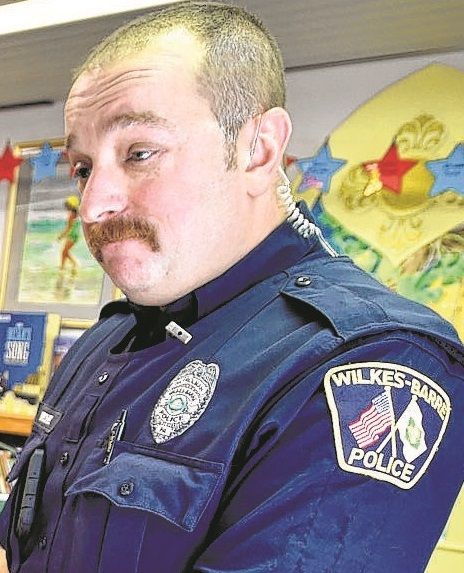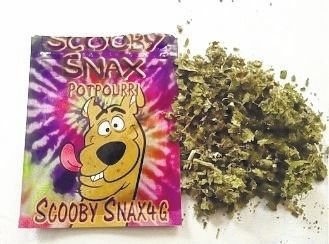Click here to subscribe today or Login.
WILKES-BARRE — The 911 calls just kept coming.
During the first week of August, area police and emergency medical technicians had their hands full responding to cases of people overdosing on a form of synthetic marijuana popularly called Spice. Many of those incidents took place outdoors, in broad daylight: On Public Square, outside the intermodal bus terminal, under the Market Street Bridge.
It seemed as if an upswing in such incidents here, which began in June, had suddenly and dramatically spiked.
We may want to blame it on “Harlem.”
That’s the street name which Wilkes-Barre police Patrolman Kirk Merchel said was given to the PCP-laced batch of the drug suspected in the outbreak of overdoses.
“Three or four people at a time, passed out,” is how Merchel described the height of the crisis.
“It was just constant,” Merchel added during a press briefing with area news agencies last week led by himself and WBPD colleagues Sgt. Phillip Myers and Patrolman Jason Oliver.
The ‘Harlem’ effect
If there is any silver lining to this cloud which descended on the Wyoming Valley, it is this: The problem may have come in and then drifted back out.
Police believe the spike was caused by the potent “Harlem” batch of adulterated Spice brought into the area by outside dealers. And Merchel said police believe those dealers have moved on, in the wake of press and police attention following the string of overdoses.
But police also know their departure could just signal a breather, thanks to the very nature of the Spice epidemic.
According to the U.S. Drug Enforcement Administration, synthetic marijuana — known by a variety of names, including Spice and K2 — is a lab-made cannabinoid drug designed to mimic the effects of tetrahydrocannabinol or THC, the key compound in organic marijuana which gets users high.
The garden variety of synthetic marijuana looks like ground-up plant material, and is sold in colorful packets labeled as potpourri or herbal incense. It is available online — or sometimes in head shops and gas stations — usually carrying a warning that it is not for human consumption.
One packet shown to reporters by city police advises users that the mixture within is intended for “aromatic therapy.”
A DEA report states that these compounds have no accepted medical use in the United States, and that while 22 synthetic cannabinoids are considered controlled substances, “DEA has identified over 75 additional synthetic cannabinoids that are not controlled but are currently appearing in the domestic marketplace, encountered by foreign agencies, or discussed on the Internet.”
That puts law enforcement agencies in a constant battle against dealers feverishly working to change formulas just enough to skirt the law.
As Oliver explained, such changes can be on the molecular level.
Oliver said some suspects can be charged with possession of a controlled substance, but as in any drug case, the contraband must be sent to the Pennsylvania State Police crime lab for testing, and “it takes some time for the results to come back.”
But in many of the recent arrests which resulted from picking seemingly stoned suspects off the street — sometimes literally — Merchel said the only possible charge was public intoxication, which is a non-traffic summary offense.
Just how many such arrests resulted this month will not formally be known until the statistics are released in September.
While users include men and women and vary by age, Merchel did say that the drug seems to have gained traction among the city’s homeless population.
PCP added?
What recently happened in Luzerne County demonstrates that some dealers aren’t much concerned whether the chemicals they’re adding are legal or not. Indeed, synthetic marijuana seems to carry its greatest value — and danger — when it is mixed with some other compound and sold illicitly in smaller doses.
“Harlem” is a case in point. Police believe its key additive was PCP, making the high not just potent, but especially dangerous.
“These people who are making it, they don’t care,” Merchel said. “Next week, it will be a different chemical compound.”
Merchel explained that the street value of spice packets which sell for $3 to $5 in New York City can be $20 to $30 here, where enterprising dealers sell the substance in smaller “dime bags” (that’s street talk for a bag containing $10 worth of marijuana) or even by the individual joint.
Dealers thus target communities such as Wilkes-Barre, knowing they can command a premium not just because of the limited supply outside major metro areas, but because of additives which give the batches their potency.
According to the National Institute on Drug Abuse (NIDA), a federal scientific research institute under the National Institutes of Health, PCP was developed in the 1950s as an intravenous anesthetic. But, NIDA notes, that use was later discontinued, due to serious adverse effects.
PCP often is applied to a leafy material such as mint, parsley, oregano, or marijuana, so users can smoke it, according to NIDA’s website, www.drugabuse.gov. Its effect on users can be dramatic, NIDA explains, including symptoms which mimic schizophrenia, such as delusions, hallucinations and paranoia.
PCP is addictive, NIDA states, and some users crave it for the feelings of strength, power and invulnerability they derive from its use.
High doses of PCP can also cause seizures, coma and death, according to NIDA.
As seen on the streets, the drug’s effects can vary widely. Some users, as in the recent Wilkes-Barre spice cases, appear to be lethargic or catatonic. Others may be violent or suicidal, according to NIDA.
Repeat offenders
That addictive potency draws repeat customers.
“We’re seeing some of the same people every day,” Merchel said.
As the Times Leader reported on Aug. 6, one man, James Matthew Bramich was arrested for the second time in less than 24 hours — and the fifth time in six days — when city police found him allegedly under the influence of synthetic marijuana on Public Square that Thursday afternoon during the height of the busy weekly Farmers Market.
In one of the previous arrests, police said Bramich was spotted by an officer with one foot on North River Street and his other foot on the sidewalk near the Luzerne County Courthouse. Bramich was unresponsive and standing still with his eyes closed and a suspected spice cigarette stuck to his lower lip. He allegedly stayed in the same position for about 15 minutes before paramedics arrived, police said.
On the afternoon of Aug. 8, Bramich, 26, and Gerald Hotchkiss, 35, were found intoxicated on a bench in front of St. Stephens Church, police said.
Bramich was difficult to wake up during the interaction and continued to lean forward with his eyes closed, swaying back and forth slowly, mumbling incoherently, police said.
Emergency personnel assessed both men and stated that they appeared to be under the influence of spice.
Both were taken into custody and transported to police headquarters, charged with public drunkenness. They were released after they no longer posed a danger to themselves or the public, police said.
Health effects
An official with the Luzerne County Coroner’s Office said she was not aware of any fatalities reported to the office as a result of the recent overdoses.
But sufferers did inundate local hospitals.
Dr. Patricia Ihnat, chairwoman of the Department of Emergency Services at Wilkes-Barre General Hospital, recalled how the flurry of synthetic marijuana overdoses earlier this month impacted her facility.
“Everybody was on high alert,” Ihnat said, reacting to a reporter’s remark about an early August afternoon when the police scanner airwaves crackled for several hours with back-to-back 911 calls.
The unpredictability of patients’ symptoms only heightened the tension.
“We have seen them come in very agitated,” Ihnat said, while others were in seizure.
“It’s a very scary situation,” she said.
Treatment, too, can vary, Ihnat said, including administering intravenous fluids, oxygen or medication. Some cases may require placing the patient on mechanical breathing devices.
Like many observers, Ihnat reflected on the mistaken belief held by some users, who view synthetic marijuana as a harmless substitute for other drugs.
“Whatever blend they are using now, I don’t think the public understands how dangerous it is,” she said.






